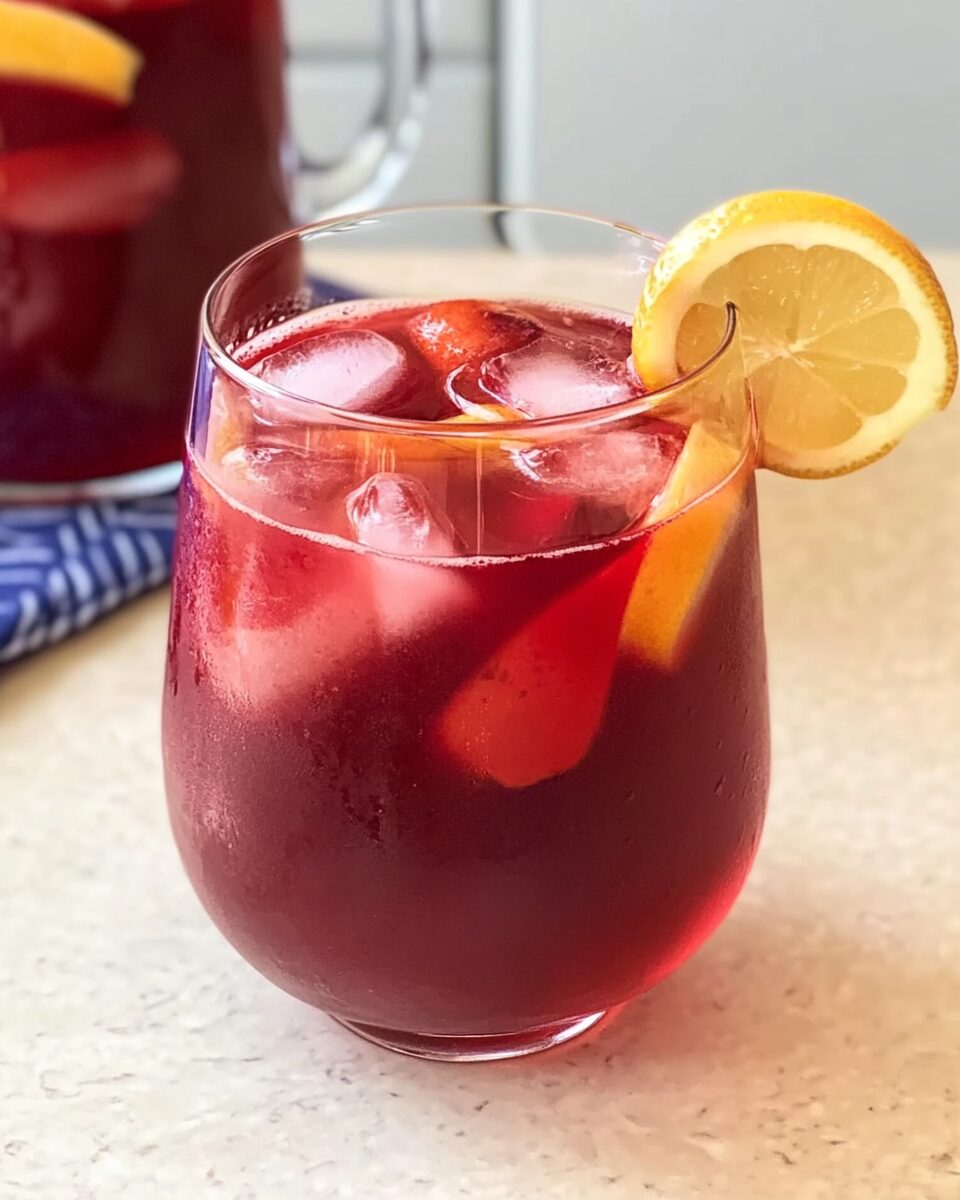Sangria is a traditional Spanish punch that combines red wine, fresh fruits, and various spirits to create a refreshing beverage. This particular recipe offers a delightful balance of citrus flavors and sweetness, making it perfect for gatherings or a relaxing evening.
Full Recipe:
Ingredients
- 1 (750 milliliter) bottle dry red wine
- ½ cup brandy
- ½ cup triple sec
- ⅓ cup frozen lemonade concentrate
- ⅓ cup orange juice
- ¼ cup lemon juice
- ¼ cup white sugar (optional)
- 1 medium orange, sliced into rounds
- 1 medium lemon, sliced into rounds
- 1 medium lime, sliced into rounds
- 8 maraschino cherries
- 2 cups carbonated water or ginger ale (optional)
Directions
- In a large pitcher, combine the red wine, brandy, triple sec, lemonade concentrate, orange juice, lemon juice, and sugar. Stir until the sugar dissolves.
- Add the sliced orange, lemon, lime, and maraschino cherries to the mixture.
- Refrigerate for at least 2 hours to allow the flavors to meld. For a more pronounced taste, let it sit overnight.
- Just before serving, add the carbonated water or ginger ale for a fizzy touch, if desired.
- Serve over ice and enjoy!
Nutrients
Per serving (approximately 1 cup):
- Calories: 200
- Carbohydrates: 20g
- Sugars: 16g
- Alcohol: 15g
The Origins of Sangria
1. Roman Influence: The Birth of Wine Punch
Sangria’s story begins over 2,000 years ago during the time of the Roman Empire. The Romans, known for their love of wine, feasting, and innovation, introduced vineyards and winemaking to the Iberian Peninsula (modern-day Spain and Portugal).
However, in ancient times, drinking plain water was risky, as it often carried harmful bacteria. To make water safer and enhance its flavor, Romans would mix it with wine, fruits, and spices. This created an early version of wine punch, which was both delicious and practical.
2. Medieval Spain: The Evolution of Flavors
During the Middle Ages, Spain became a hub for trade and cultural exchange, thanks to its strategic location. New ingredients were introduced from around the world, including:
- Citrus fruits (oranges, lemons, and limes)
- Cinnamon, cloves, and nutmeg
- Sweeteners like honey and sugar
These ingredients were incorporated into wine, creating a more flavorful, aromatic version of early sangria. Spanish nobility and commoners alike enjoyed this refreshing drink, setting the stage for its modern-day form.
3. The 18th and 19th Century: Sangria Gets Its Name
The word “sangria” is derived from the Spanish word “sangre,” meaning “blood,” referring to its deep red color. By the 18th and 19th centuries, sangria had become a common drink in Spain and Portugal, often served at celebrations, weddings, and social gatherings.
Different regions began experimenting with local wines, fruits, and liqueurs, leading to the first variations of sangria. These included white wine sangria, sparkling sangria, and even fortified sangria with brandy or sherry.
Sangria’s Rise to Global Fame
1. The 1964 New York World’s Fair: A Turning Point
Sangria remained largely a Spanish tradition until the 1964 World’s Fair in New York City. At the Spanish Pavilion, visitors were served authentic sangria, and the world fell in love with its sweet, fruity, and refreshing taste.
After the event, sangria exploded in popularity across the United States, Europe, and Latin America. It became a staple at Spanish restaurants, tapas bars, and summer parties.
2. Sangria in Pop Culture and Modern-Day Appeal
Today, sangria is enjoyed worldwide and frequently appears in:
- Restaurants and bars as a signature house drink
- Summer festivals and outdoor picnics
- Family gatherings and casual get-togethers
- Brunch menus and holiday parties
Its versatility makes it perfect for any occasion, and with so many variations, there’s a sangria for everyone.
Traditional and Modern Variations of Sangria
Sangria is highly customizable, and its variations depend on regional preferences and personal tastes. Here are some of the most popular types:
1. Classic Red Sangria
- Base: Dry red wine (such as Tempranillo or Rioja)
- Additions: Citrus fruits, apples, and berries
- Liquor: Brandy or triple sec
- Sweetener: Sugar, honey, or fruit juice
- Sparkling touch: Club soda or ginger ale
2. White Sangria (Sangria Blanca)
- Base: White wine (Sauvignon Blanc, Pinot Grigio)
- Fruits: Peaches, apples, and pears
- Liqueur: Elderflower or peach schnapps
- Light and refreshing, perfect for summer!
3. Sparkling Sangria
- Base: Spanish Cava or Prosecco
- Fruits: Strawberries, raspberries, citrus slices
- Best for festive occasions and celebrations
4. Winter Sangria (Mulled Sangria)
- Base: Full-bodied red wine (Cabernet Sauvignon)
- Warm spices: Cinnamon, cloves, star anise
- Sweeteners: Honey or brown sugar
- Served warm for a cozy holiday drink
Health Benefits of Sangria
While sangria is an alcoholic drink, it can provide some health benefits when consumed in moderation.
1. Red Wine and Heart Health
Red wine contains antioxidants like resveratrol, which can:
- Support heart health
- Improve circulation
- Reduce inflammation
2. Fruits Provide Essential Nutrients
Sangria contains natural vitamins and minerals from fruits like oranges, lemons, and berries. Vitamin C boosts the immune system, while fiber aids digestion.
3. Lower Alcohol Content Compared to Cocktails
Since sangria is mixed with fruit juices and soda, its alcohol content is lower than traditional cocktails, making it a lighter, more hydrating option.
Best Occasions to Enjoy Sangria
Sangria is a drink for all seasons, but some occasions make it even more special:
- Summer BBQs and Pool Parties – Refreshing and easy to prepare
- Brunch Gatherings – Pairs well with light dishes like seafood and salads
- Holiday Celebrations – Warm, spiced sangria makes the perfect winter drink
- Date Nights and Dinners – A romantic addition to any meal
Tips for Making the Perfect Sangria
-
Choose the Right Wine:
- Use a dry, affordable wine – no need for expensive bottles
- For red sangria: Spanish Tempranillo or Garnacha
- For white sangria: Sauvignon Blanc or Verdejo
-
Let It Chill:
- Sangria tastes best after 2-4 hours in the fridge
- This allows the flavors to blend beautifully
-
Balance the Sweetness:
- Use natural sweetness from fruits instead of too much sugar
-
Add a Sparkling Touch:
- A splash of club soda or sparkling wine enhances freshness
Conclusion
Sangria is more than just a drink—it’s a celebration of Spanish heritage, creativity, and shared moments. With roots in Roman history, it has evolved into a global favorite, enjoyed by millions. This vibrant, fruity wine-based punch is enjoyed worldwide for its bold flavors, refreshing taste, and festive appeal. Whether served at a summer barbecue, a cozy holiday gathering, or a tapas night with friends, sangria adds a touch of elegance and fun to any occasion. But sangria is not just about great taste—it has a fascinating history that dates back thousands of years. Its endless variations, health benefits, and versatility for any occasion make it one of the most exciting and customizable drinks out there.






